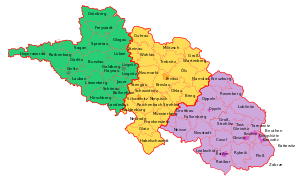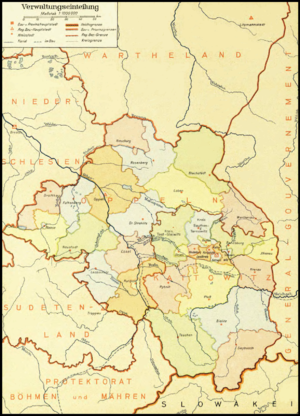Opole administrative district

The administrative district of Opole was an administrative district in the Prussian province of Silesia . It existed from 1813 to 1945 and covered the south-eastern part of Silesia. 1919–1938 and from 1941 Silesia was divided into two provinces; the old administrative district of Opole then formed the province of Upper Silesia . In 1939, because of the annexations of Polish territory, the administrative district of Katowice and a newly delimited administrative district of Opole were formed, which existed until 1945.
geography
The administrative seat of the administrative district was in the Upper Silesian city of Opole . Other important cities in the administrative district were mainly the large cities of the Upper Silesian coal mining area, i. hu a. Katowice , Gleiwitz , Beuthen , Königshütte and Hindenburg , outside of this metropolitan area mainly Ratibor , Neustadt , Neisse and Kreuzburg .
The northwestern part of Silesia belonged to the Wroclaw administrative district . In the north the administrative district bordered for a few kilometers on the Kempen district in the province of Posen , in the east on Russia , from 1919 on Poland , in the south on the Austrian crown lands Galicia (from 1919 Poland) and Austrian Silesia (from 1919 Czechoslovakia ).
The administrative district comprised the following urban and rural districts (as of 1910):
District President
- 1816–1820: Carl Heinrich Fabian von Reichenbach
- 1820-1823: NN
- 1823–1837: Theodor Gottlieb von Hippel the Younger
- 1835–1858: Erdmann von Pückler
- 1858–1871: Georg von Viebahn
- 1871–1877: Robert Eduard von Hagemeister
- 1878–1881: Konstantin von Quadt and Hüchtenbruck
- 1881–1886: Robert von Zedlitz-Trützschler
- 1886–1888: Traugott von Baudissin
- 1888–1898: Rudolf von Bitter the Younger
- 1898–1900: Friedrich von Moltke
- 1900–1901: Max von Pohl
- 1901–1907: Ernst Holtz
- 1907–1916: Friedrich Ernst von Schwerin
- 1916–1917: Oskar Hergt
- 1917–1919: Walther von Miquel
- 1919–1921: Joseph Bitta
- 1921–1923: Roland Brauweiler
- 1923–1929: Alfons Proske
- 1929–1933: Hans Lukaschek
- 1933–1936: Artur Schmidt-Kügler
- 1936–1937: Josef Adamczyk
- 1937–1941: Hans Rüdiger
- 1941–1944: Albrecht Schmelt
- 1944–1945: Herbert Mehlhorn ( substitute )
population
Development of the ethnolinguistic structure
| year | Polish | German | Others (including bilingual) | |||
|---|---|---|---|---|---|---|
| absolutely | percentage | absolutely | percentage | absolutely | percentage | |
| 1819 | 377.100 | 67.2% | 162,600 | 29.0% | 21,503 | 3.8% |
| 1828 | 418,437 | 61.1% | 255.483 | 37.3% | 10,904 | 1.6% |
| 1831 | 456.348 | 62.0% | 257.852 | 36.1% | 13,254 | 1.9% |
| 1834 | 468.691 | 62.6% | 266,399 | 35.6% | 13,120 | 1.8% |
| 1837 | 495,362 | 62.1% | 290.168 | 36.3% | 12,679 | 1.6% |
| 1840 | 525.395 | 58.6% | 330.099 | 36.8% | 41,570 | 4.6% |
| 1843 | 540.402 | 58.1% | 348.094 | 37.4% | 42,292 | 4.5% |
| 1846 | 568,582 | 58.1% | 364.175 | 37.2% | 45,736 | 4.7% |
| 1852 | 584.293 | 58.6% | 363,990 | 36.5% | 49,445 | 4.9% |
| 1855 | 590.248 | 58.7% | 366,562 | 36.5% | 48,270 | 4.8% |
| 1858 | 612,849 | 57.3% | 406,950 | 38.1% | 49,037 | 4.6% |
| 1861 | 665.865 | 59.1% | 409.218 | 38.3% | 51.187 | 4.6% |
| 1867 | 742.153 | 59.8% | 457,545 | 36.8% | 41,611 | 3.4% |
| 1890 | 918.728 | 58.2% | 566,523 | 35.9% | 92,480 | 5.9% |
| 1900 | 1,048,230 | 56.1% | 684.397 | 36.6% | 135,519 | 7.3% |
| 1905 | 1,158,805 | 56.9% | 757.200 | 37.2% | 117,651 | 5.8% |
| 1910 | 1,169,340 | 53.0% | 884.045 | 40.0% | 154,596 | 7.0% |
Web links
- Administrative district of Opole Administrative history and list of regional presidents on the website territorial.de (Rolf Jehke), as of July 22, 2013.
Individual evidence
- ↑ Georg Hassel: Statistical outline of all European and the most distinguished non-European states, in terms of their development, size, population, financial and military constitution, presented in tabular form; First issue: Which represents the two great powers Austria and Prussia and the German Confederation ; Verlag des Geographisches Institut Weimar (1823), p. 34; (Total population in 1819: 561,203; Moravians: 12,000; Jews: 8,000 and Czechs: 1,600)
- ↑ a b c d e f g h i j k l Paul Weber: The Poles in Upper Silesia: a statistical study ; Julius Springer's publishing bookstore in Berlin (1913), pp. 8–9
- ^ A b c d Paul Weber: The Poles in Upper Silesia: a statistical study ; Julius Springer's publishing bookstore in Berlin (1913), p. 27





